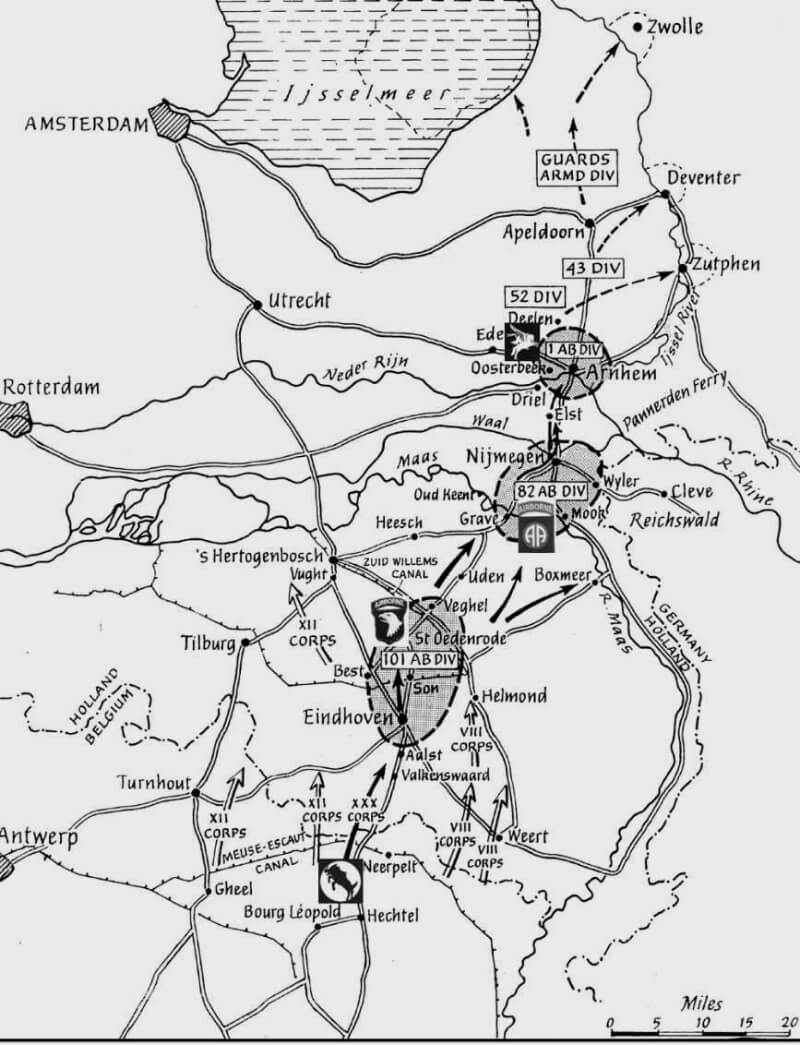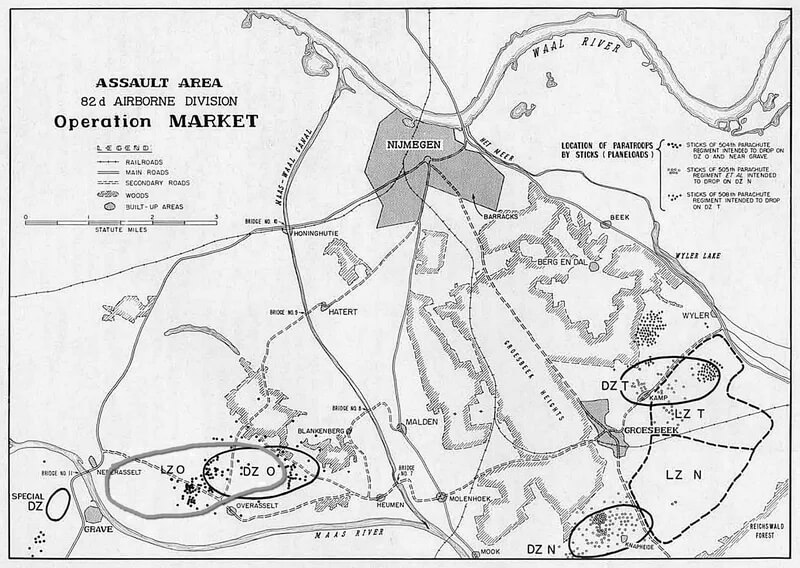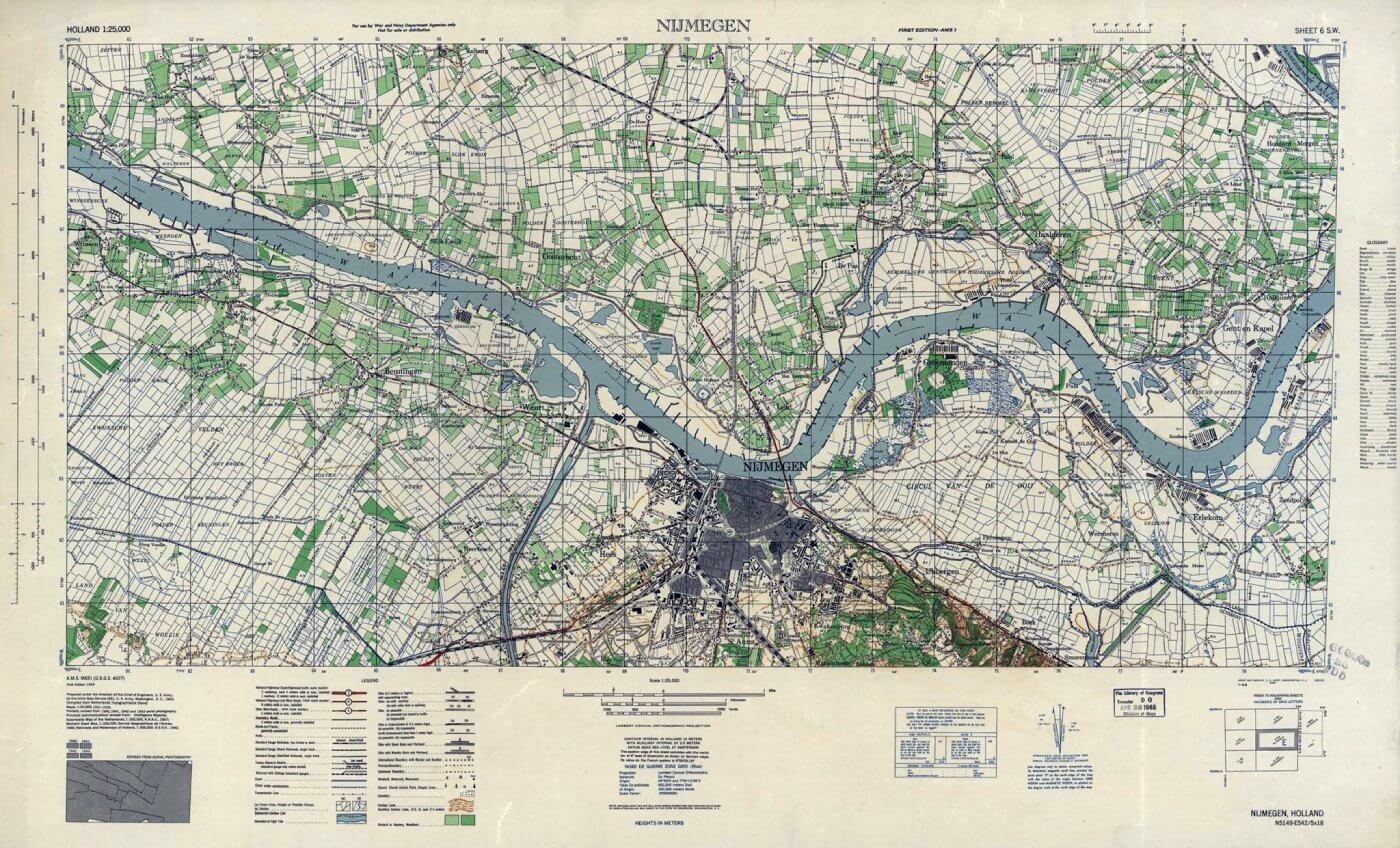| Page Created |
| August 16th, 2024 |
| Last Updated |
| October 24th, 2024 |
| The United States |
 |
| Operation Market Garden |
| 1st Airborne Division 1st Polish Independent Parachute Brigade 82nd Airborne Division 101st Airborne Division XXX Corps |
| Other Units Involved |
| 1st Airborne Division 1st Polish Independent Parachute Brigade 82nd Airborne Division 101st Airborne Division |
| September 17th, 1944 – September 26th, 1944 |
| Operation Market Garden |
| Objectives |
 Under Construction
Under Construction- Land at designated drop zones in Groesbeek, Overasselt, and Grave.
- Secure the high ground around Groesbeek, which is vital for controlling the surrounding area.
- Capture the key bridges over the Waal River at Nijmegen, the Maas River at Grave, and at least one bridge over the Maas-Waal Canal.
- Link up with the advancing ground forces of the 30th Corps.
| Operational Area |
Nijmegen Area, The Netherlands
| Allied Forces |
- 82nd Airborne Division
| Axis Forces |
| Operation |

The 82nd Airborne Division, is assigned the area around Nijmegen, with designated drop zones in Groesbeek, Overasselt, and Grave. The division’s primary objectives include securing the high ground around Groesbeek, which is vital for controlling the surrounding area, and capturing several key bridges: those over the Waal River at Nijmegen, the Maas River at Grave, and at least one bridge over the Maas-Waal Canal. The Waal Bridge at Nijmegen, however, is initially given lower priority, leading to its capture only after several days of intense combat. The high ground at Groesbeek is particularly important because it dominates the Reichswald, an alternative route that bypasses the northern end of the Westwall.
Faced with this complex airborne mission, Brigadier General James M. Gavin, the new commander of the 82nd Airborne Division, confronts significant challenges. Known as “Slim Jim” to his men, Gavin has already led the 505th Parachute Infantry Regiment in combat in the Mediterranean. During his time in the Great Britain for the Operation Overlord planning, he serves as General Eisenhower’s airborne advisor and takes on the role of Assistant Divisional Commander of the 82nd Airborne Division during the Normandy invasion. Upon the division’s return to the Great Britain, Gavin, at the age of 37, becomes the youngest divisional commander in the U.S. Army during World War II.
Gavin outlines the objectives for the 82nd Airborne Division in the Nijmegen area, foreseeing multiple challenges. Their tasks include securing the long bridge over the Maas River at Grave, holding the high ground around Groesbeek, capturing at least one of the four bridges over the Maas-Waal Canal, and finally, seizing the critical Nijmegen road and rail bridges.
Gavin expresses concern over the potential dispersal of his forces during the initial landings, fearing large gaps in the perimeter they must hold. Drawing on lessons from the Sicily campaign, he believes it is better to land close to the objective, even with heavy casualties, than to fight overland. However, with so many targets spread across an area of approximately 40 kilometres, he worries that the division could lose control immediately after landing if the allocation of troops to specific objectives is mishandled.
In contrast to XXX Corps and the 101st Airborne Division, which are to fight through the German 1. Fallschirmjäger Armee’s forward lines, the 82nd Airborne Division is to drop into the enemy’s Rear Combat Zone. Gavin expects to encounter only communications troops and disorganised formations, but this underestimates the German capacity for rapid mobilisation. The Market Garden plan places the 82nd Airborne Division’s drop zones near the boundary of the Netherlands Military District and Wehrkreis VI in Germany, an area housing numerous training schools and rear-echelon units. While these units are often composed of wounded, older, or inexperienced soldiers, some troops are still capable of mounting a strong defence.
Gavin is also aware of reports about armoured divisions refitting in the nearby Reichswald forest. These turn out to be elements of the II SS Panzer Corps, which would later confront the 1st Airborne Division near Arnhem. Though assessed at only 20% of their strength, the Germans’ ability to fight effectively with ad hoc formations proves a challenge to the widely dispersed American paratroopers.
On Sunday, September 17th, 1944, the airlift for Gavin’s division is only able to drop three parachute infantry regiments and a single artillery battalion, along with limited divisional support by glider. Their mission is to secure the various bridges, Drop Zones, Landing Zones, and to capture one or both of the Nijmegen bridges. The inability to use gliders to seize the Nijmegen Road Bridge presents a significant setback, restricting their options.

The 504th Parachute Infantry Regiment is assigned to Drop Zones Easy and Oscar, positioned in the triangle formed by the Maas River and the Maas-Waal Canal. Their objective is to secure the bridges over these waterways, allowing the British Guards Armoured Division, leading XXX Corps, to advance towards Nijmegen and Arnhem. Meanwhile, the 505th Parachute Infantry Regiment is dropped on Drop Zone November, south of Groesbeek, with orders to capture the Maas Railway Bridge at Molenhoek and secure the southwest part of the Groesbeek Heights and its associated Landing Zones. Additionally, 2nd Battalion, 505th Parachute Infantry Regiment, is to assist the 504th Parachute Infantry Regiment in taking the Maas-Waal Canal bridges from the east, following the division’s strategy of simultaneous attacks from both ends of a bridge. Afterward, the 2nd Battalion, 505th Parachute Infantry Regiment will act as the division’s reserve.
Lastly, the 508th Parachute Infantry Regiment lands on Drop Zone Tango with the task of securing the high ground between Groesbeek and Nijmegen, overseeing the border with Germany. They are also to send a battalion to the Nijmegen bridges to ensure their capture and control.
Gavin’s careful planning and strategic concerns reflect the immense complexity of the operation, but the days ahead would test the division’s ability to overcome these obstacles.
| September 17th, 1944 |
| September 18th, 1944 |
| September 19th, 1944 |
| September 20th, 1944 |
| September 21st, 1944 |
| September 22nd, 1944 |
| September 23rd, 1944 |
| September 24th, 1944 |
| September 25th, 1944 |
| September 26th, 1944 |
| Multimedia |

